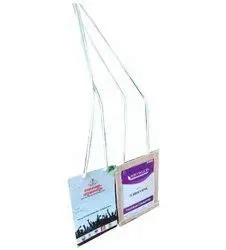Hey there, business owners and design enthusiasts! Ever stopped to think about your company ID cards? They’re more than just a piece of plastic; they’re a walking advertisement, a symbol of your brand, and a crucial tool for security and access control. But with so many design trends popping up, how do you choose the right one? Let’s dive into the exciting world of innovative business ID card designs, focusing on eco-friendly options and beyond.
We’ll explore everything from the latest materials and printing techniques to the integration of cutting-edge technology. Think of this as your ultimate guide to creating ID cards that are not only stylish and functional but also reflect your company’s values and commitment to sustainability.
The Rise of Eco-Conscious ID Cards:
Let’s face it, the traditional plastic ID card isn’t exactly known for its eco-friendliness. But times are changing! More and more businesses are embracing sustainable practices, and that includes their ID cards. Why? Because consumers are increasingly aware of environmental issues and are actively seeking out companies that share their values. Choosing eco-friendly ID card materials is a fantastic way to showcase your commitment.
So, what does “eco-friendly” actually mean in the context of ID cards? It’s about using sustainable materials, such as recycled plastic or plant-based alternatives, and employing printing methods that minimize waste and harmful emissions. Imagine the impact you could make by simply switching to a more sustainable option! It’s a small change with big consequences. You can learn more about eco-friendly business solutions here.
Beyond the Basics: Innovative Design Elements:
Beyond eco-consciousness, there’s a whole universe of innovative design trends shaping the future of business ID cards. Let’s explore some exciting possibilities:
Minimalist Designs: Clean lines, simple typography, and a restrained color palette are key to this trend. It’s all about letting your brand’s logo and key information speak for themselves. Think of it as a breath of fresh air in a world of cluttered designs.
Geometric Patterns: Bold and modern, geometric patterns add a touch of sophistication and visual interest. These can be subtly incorporated into the background or used to create a striking border.
Custom Illustrations: For a truly unique touch, consider incorporating custom illustrations that reflect your company’s culture and values. This adds a personal touch and makes your ID cards instantly recognizable.
Interactive Elements: Technology is changing everything, and ID cards are no exception. Imagine an ID card with a QR code that links to your employee’s contact information or a digital badge that can be used for access control. We discuss technology-integrated ID cards on our blog.
Personalized Designs: Just like a good marketing campaign speaks directly to its audience, custom ID card design allows each employee to have a unique card representing their role and identity within your company. A level of personalization can give employees a stronger sense of identity within the workplace. For inspiration, visit our blog on customization and personalization in ID card design.
Material Matters: Choosing the Right Stuff:
The material you choose for your ID cards has a significant impact on both their durability and their environmental footprint. Here are a few options to consider:
Recycled PVC: A sustainable alternative to virgin PVC, recycled PVC reduces waste and lowers the environmental impact of your ID cards.
Bio-based Plastics: Made from renewable resources like plants, bio-based plastics offer a more eco-friendly option without compromising on durability.
Paper Cards: For a truly sustainable choice, consider paper cards. While perhaps not as durable as plastic, they are fully biodegradable and compostable.
Printing Techniques for a Greener Future:
The printing process itself also plays a role in the sustainability of your ID cards. Here are some eco-conscious choices:
Soy-based Inks: These inks are made from renewable resources and are biodegradable, minimizing the environmental impact.
UV-Curable Inks: These inks cure instantly using UV light, reducing the need for solvents and minimizing emissions.
Digital Printing: Digital printing techniques allow for smaller print runs and reduce waste compared to traditional methods. Learn more about eco-friendly printing techniques in our resources section.
Industry-Specific Considerations:
Your ID card design should also reflect the unique needs and identity of your industry. For example, a construction company might require durable cards with clear identification, whereas a creative agency might opt for a more stylish and modern design. Check out our blog on industry-specific ID card designs for some specific examples. We also have resources on the functional aspects of industry-specific ID cards and design trends in industry-specific ID cards
Integrating Technology:
Integrating technology into your ID cards can significantly enhance security and functionality. Consider features like:
NFC (Near Field Communication): Enable contactless access control and data sharing.
QR Codes: Link to employee profiles, emergency contacts, or other relevant information.
Holograms: Add an extra layer of security to prevent counterfeiting.
Digital ID Cards: Consider the possibilities of digital and virtual ID cards, which are both space-saving and eco-friendly. You can check out our extensive guide on digital and virtual ID cards.
Branding Your Business:
Don’t forget that your ID cards are a powerful branding opportunity. They’re a tangible representation of your company’s image and values. Make sure your design incorporates your logo, color scheme, and overall brand aesthetic. We’ve created several blog posts around corporate branding with ID cards and branding with ID cards that might help you.
The Future of Business ID Cards:
The future of business ID cards is bright, innovative, and increasingly sustainable. As technology advances and environmental awareness grows, we can expect to see even more creative and eco-friendly designs emerge. Consider how the integration of sustainable practices can directly impact the bottom line and company image.
Conclusion:
Designing your business ID cards doesn’t have to be a daunting task. By considering the latest trends, choosing eco-friendly materials, and integrating technology where appropriate, you can create ID cards that are both stylish and functional. Remember, your ID cards are a reflection of your brand, and investing in a thoughtful design can have a significant impact on your company’s image and sustainability efforts. So, let your ID cards reflect your company’s values and make a statement that’s both stylish and responsible. For more design inspiration, check out our blog on modern ID card design ideas and explore the broader world of ID card design and business solutions.
FAQs:
1. What are the most sustainable materials for ID cards? Recycled PVC, bio-based plastics, and paper are all excellent eco-friendly choices.
2. How can I incorporate my company branding into my ID card design? Use your logo, color scheme, and typography to create a cohesive design that reflects your brand identity.
3. What are the benefits of using technology in ID cards? Technology enhances security, streamlines access control, and improves efficiency.
4. What are some of the latest design trends in business ID cards? Minimalist designs, geometric patterns, custom illustrations, and interactive elements are all popular choices.
5. Where can I find more information on eco-friendly ID card manufacturing? Check out our blog for a range of articles on eco-friendly materials, printing techniques, and design trends. Specifically check out our resources on sustainable ID card materials and sustainable and eco-friendly tech

